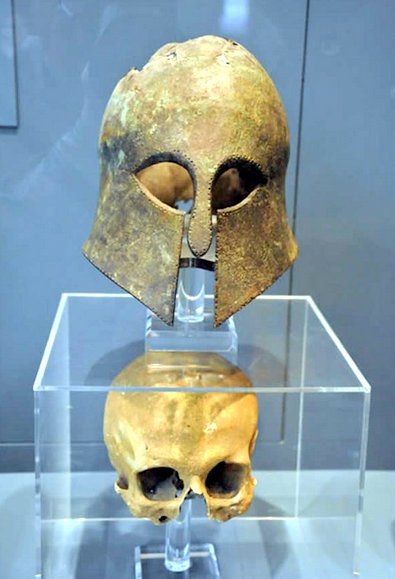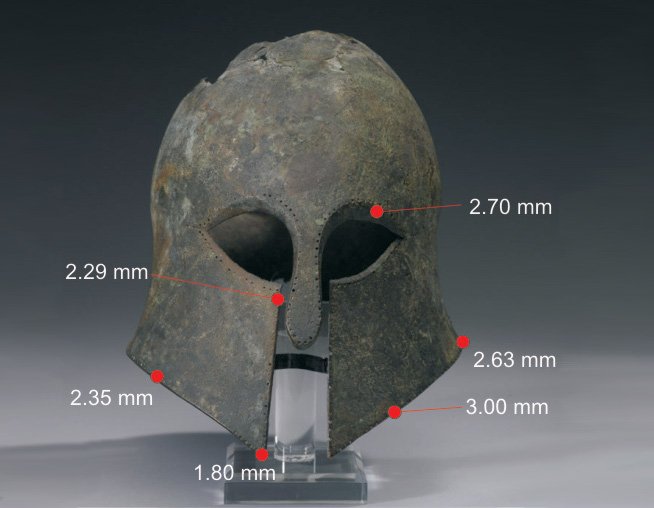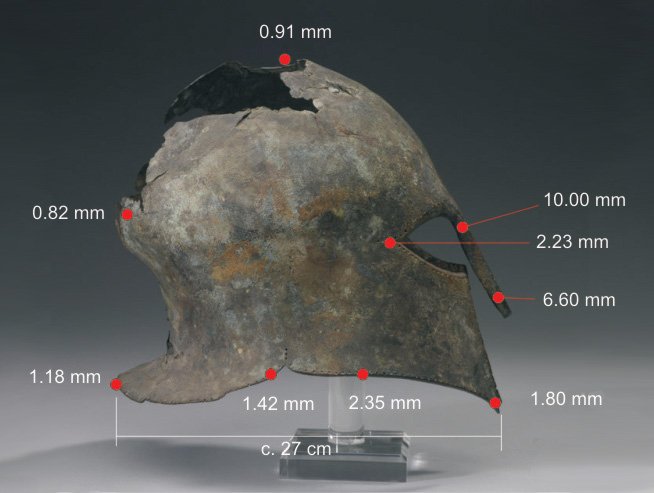The Corinthian helmet type, iconic in its design, holds a romantic allure as it is associated with the legendary heroes of Ancient Greece. Although the Ancient Greeks themselves moved on to helmet types offering better visibility, they continued to depict their heroes donning these distinctive helmets. In modern portrayals of Ancient Greek warriors, the Corinthian helmet is the go-to representation, often modified for aesthetic purposes.

The Discovery and Acquisition of the Helmet
This specific Corinthian helmet (ROM no.926.19.3) was acquired by the ROM (Royal Ontario Museum) in 1926 from T. Sutton of 2 Albemarle St., London, England, through an auction at Sotheby’s on July 22, 1926 (lot 160). The helmet was said to contain a skull (ROM No. 926.19.5) and was excavated by George Nugent-Grenville, 2nd Baron Nugent of Carlanstown, on the Plain of Marathon in 1834. Correspondence from Sutton in August 1826 mentions the excavation, and the lot also included a “Spartan type” helmet (ROM no. 926.19.4) discovered by Nugent at Thermopylae in the same year. Nugent, who served as the High Commissioner of the Ionian Islands from 1832-5, acquired these artifacts, which had been passed down through the Boileau family, and eventually sold them to Sutton.
The Battle of Marathon and Historical Significance
The Battle of Marathon in 490 BC stands as one of history’s pivotal clashes. This battle saw the Greeks emerge victorious against the invading Persians, a triumph that paved the way for the development of Greek Classical civilization. Nugent’s interest in the artifacts from Thermopylae suggests a connection to the battle of 480 BC, where 300 Spartans, along with other Greeks, valiantly defended the pass against the Persian invasion. While the attribution of the helmets to these specific battles cannot be entirely confirmed, Nugent’s presence in Greece shortly after its liberation during the Greek War of Independence (1821-1832), when the British Navy played a significant role, makes the discovery plausible.

The Enigmatic Skull and Helmet Association
Establishing a definitive association between the skull and the helmet proves challenging. As the Greeks emerged victorious at Marathon, they would not have left any body parts or useful equipment behind on the battlefield. The helmet’s damage appears to be from aging rather than battle-related. It is equally unlikely for a helmet to be lost along with the head it protected. While we possess the helmet, we cannot discount the possibility that the skull belonged to its original wearer. However, due to a century-long gap between the finding of the artifacts and our records, uncertainties arise regarding the accuracy of information transmission, especially since Nugent’s descendants did not inherit his house and its contents. A DNA and radiocarbon study could potentially shed light on the skull’s origins, but such analysis is not currently planned.
The Corinthian Helmet’s Construction and Characteristics
During an examination of the Nugent Marathon helmet, researchers aimed to provide information to Matt Lukes, who crafts equipment for reenactors and sought to create a replica of the Corinthian helmet. The study involved investigating the fabrication process. The hope was that the helmet had been raised from a bronze sheet, allowing for the replica to be made by spinning the sheet on a lathe to create a bowl-like form that could then be shaped further. The examination also revealed the helmet’s thickness in various parts, with the face being relatively thick, measuring between 2 mm and 3 mm, including a nasal that reached up to 10 mm. The back and crown of the helmet were notably thinner, measuring less than 1 mm. The design’s strength effectively protected the face during the hoplite warfare of the Greeks, where spear thrusts were employed alongside a large round shield.

In summary, the discovery of this Corinthian helmet from the Battle of Marathon, potentially linked to the skull found within, adds to our understanding of Ancient Greek warfare and the significance of this historic conflict. While mysteries remain, this artifact continues to captivate scholars and enthusiasts alike, offering glimpses into the military and cultural practices of the time.

Video